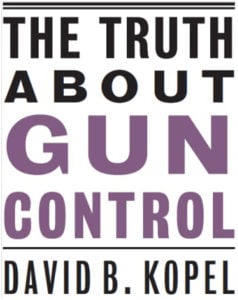The Truth about Gun Control, by David B. Kopel. New York: Encounter Books, 2013. Broadside series No. 32. 44 pp. $5.99 (paperback).

Should government further restrict the ability of rights-respecting Americans to buy, own, and carry guns, or should it recognize that ability as a basic right and protect it? David B. Kopel, among the most influential Second Amendment scholars working today, makes a terse but cogent argument for the right to keep and bear arms in his latest book, The Truth about Gun Control.
Part of the Broadside series by Encounter Books, Kopel’s book is very short, only 44 small pages. A publisher’s note in the book explains that the series seeks to unite “an 18th-century sense of political urgency (think The Federalist Papers, Common Sense) with 21st-century technology and channels of distribution.” Although none of the works in the series is destined to be nearly as influential as those founding-era works, Kopel’s book ably meets its objective.
Kopel focuses on the history of gun ownership and gun control in America, and he makes his arguments about gun rights within that historical context. In the first paragraph of the book, he sets some key context:
Today’s war on Second Amendment rights . . . continues an American cultural war that has been going on for half a century. The roots of the gun-control movement can be traced back even further, to Reconstruction and attempts to disarm the freedmen, and before that to the British gun-confiscation program that sparked the American Revolution. (p. 1)
And he soon indicates the essence of the original case for the right to bear arms—the case made by Enlightenment thinkers such as Samuel Pufendorf, John Locke, and America’s founders. Kopel summarizes: “A necessary corollary to the natural right of self-defense is the right to defensive arms. For most people, some sort of arm is the only practical way in which they can vindicate their inherent right of self-defense” (p. 3).
Kopel covers three main periods of history: the clash over guns between the colonists and the British government that sparked the American Revolution, the attempts by racists to disarm blacks following the Civil War, and efforts to restrict guns since Prohibition.
On this last point, Kopel suggests a direct link between the prohibition of alcohol and the gun-control movement: “National alcohol prohibition, enacted in 1920, spurred national violence, which resulted in the conservative Eastern business establishment—along with some religious pacifists—demanding handgun prohibition” (pp. 15–16).
Kopel briefly (perhaps too briefly) discusses the contemporary debates over background checks, so-called “assault weapons,” and gun magazines. For example, he argues that the “phony issue of ‘assault weapons’ is based on a hoax invented by the gun-prohibition lobbies and spread by willfully ignorant media,” that hoax being that the guns in question “function like [fully automatic] machine guns” (p. 17). Addressing the essential facts about these guns, Kopel explains:
They fire only one round each time the trigger is pressed, just like any other ordinary gun. They are not more powerful than other guns; as rifles go, they are intermediate in power. . . .
Today, semiautomatic handguns comprise 82% of new handguns manufactured in the U.S. Citizens buying such guns often choose guns with standard magazines holding 11 to 20 rounds. For rifles today, magazines of up to 30 rounds are factory standard.
Ordinary citizens choose these handguns, rifles, and magazines for the same reason that ordinary police officers usually do: because they are often the best choice for lawful defense of self and others. (pp. 17, 19)
If you are seeking a highly detailed account of the history of and controversies surrounding the right to keep and bear arms, you might do better to read the academic articles and full-length books by Kopel and other scholars working in the field. But if you’re looking for an overview of that history and the basic arguments supporting the right to keep and bear arms, you would do well to read Kopel’s new little book. It will quickly arm you with the basic facts.


![[TEST] The Objective Standard](https://test.theobjectivestandard.com/wp-content/uploads/2017/10/logo.png)













